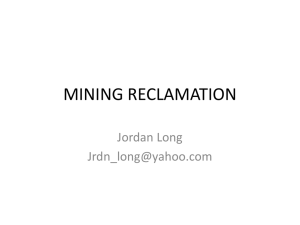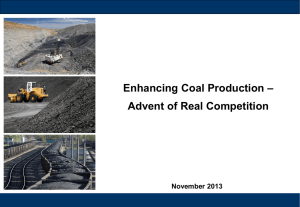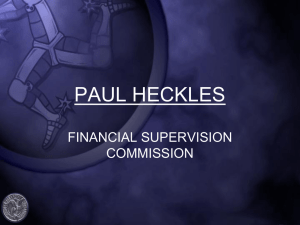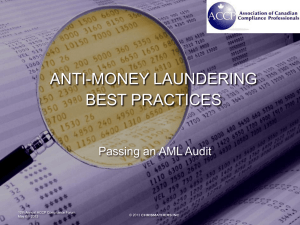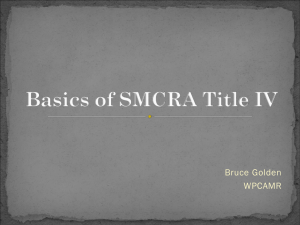a Powerpoint Presentation on Reauthorization of AML
advertisement
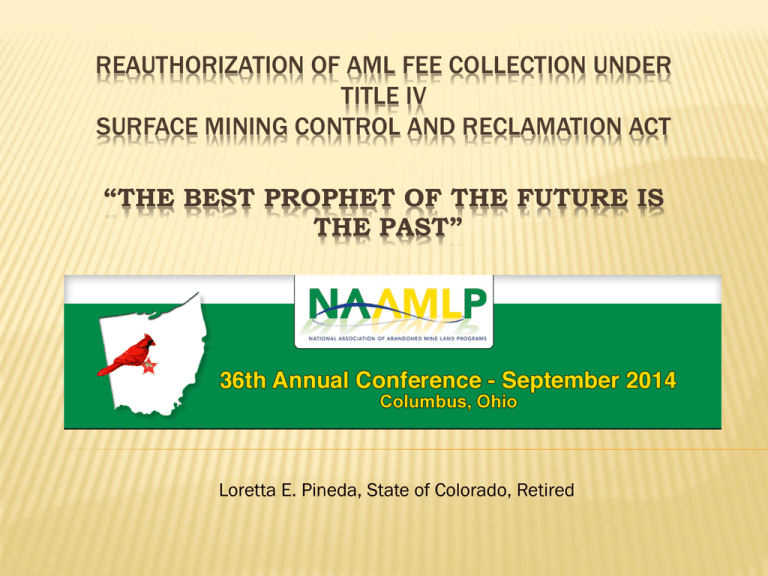
REAUTHORIZATION OF AML FEE COLLECTION UNDER TITLE IV SURFACE MINING CONTROL AND RECLAMATION ACT “THE BEST PROPHET OF THE FUTURE IS THE PAST” Loretta E. Pineda, State of Colorado, Retired BEFORE SMCRA Early coal mine regulations - West Virginia in 1939, Indiana in 1941, Illinois in 1943, and Pennsylvania in 1945. . The great demand for coal during WWII led to coal being mined with little regard for environmental consequences. Meanwhile, surface mining became increasingly common: in 1963 just 33 percent of American coal came from surface mines; by 1973 that figure reached 60 percent ENVIRONMENTAL MOVEMENT 1960’S SMCRA grew out of a concern about the environmental effects of strip mining Congress first held hearings on surface coal mining regulation in 1968. In 1974 and 1975 Congress sent mining regulation bills to President Gerald Ford but he vetoed them out of concern that they would harm the coal industry, increase inflation, and restrict the energy supply AUGUST 3, 1977 As Jimmy Carter campaigned in Appalachia in 1976, he promised to sign legislation dealing with strip mining. President Carter signs SMCRA into law. The Act establishes the Office of Surface Mining Reclamation and Enforcement within the Department of the Interior to carry out the provisions of the law. SMCRA was the first federal environmental statute to regulate a specific industry as opposed to a specific type of pollution. It created two major programs: An abandoned mine land (AML) reclamation program, funded by fees that operators pay on each ton of coal produced, to reclaim land and water resources adversely affected by coal mines abandoned before August 3, 1977. A regulatory program to ensure that surface coal mining operations initiated or in existence after the effective date of the Act are conducted and reclaimed in an environmentally sound manner. ORIGINAL FEE COLLECTION As originally enacted, section 402(b) of SMCRA authorized collection of reclamation fees for 15 years following the date of enactment (August 3, 1977); thus, the fee collection authority would have expired August 3, 1992. CHANGES/EXTENSIONS Aug. 3, 1977, P.L. 95-87, Title IV, § 402, 91 Stat. 457 May 7, 1987, P.L. 100-34, Title I, § 101, 101 Stat. 300 Nov. 5, 1990, P.L. 101-508, Title VI, Subtitle A, §§ 6003, 6004, 104 Stat. 1388-290, 1388-291 Oct. 24, 1992, P.L. 102-486, Title XIX, Subtitle C, § 19143(b)(1), (2), (3)(B), Title XXV, § 2515, 106 Stat. 3056, 3113.) As amended Dec. 8, 2004, P.L. 108-447, Div E, Title I, § 135(a), 118 Stat. 3068 May 11, 2005, P.L. 109-13, Div A, Title VI, § 6035, 119 Stat. 289 Aug. 2, 2005, P.L. 109-54, Title I, § 129, 119 Stat. 525 June 15, 2006, P.L. 109-234, Title VII, § 7007, 120 Stat. 483 Dec. 20, 2006, P.L. 109-432, Div C, Title II, Subtitle A, § 202, 120 Stat. 3008 Oct. 3, 2008, P.L. 110-343, Div C, Title VI, § 602, 122 Stat. 3911 1977-1983 October 25, 1978 -OSM publishes final rules for administration of the abandoned mine land reclamation program. March 31, 1979 -OSM publishes final rules for the permanent regulatory program. February 27, 1980 through December 23, 1983 OSM approves 25 state regulatory programs and 22 state abandoned mine land reclamation plans. MAY 7, 1987, P.L. 100-34 Amended SMCRA to permit States to set aside in a special trust fund up to 10 percent of the annual State funds from the Abandoned Mine Land Reclamation Fund for expenditure in the future for purposes of abandoned mine reclamation. In the future… PROGRESS – 10 YEARS From 1977 to 1987, many of the scars left from past mining practices had been reclaimed. In 1987 the NAAMLP reported 6,203 mine sites encompassing 65,750 acres reclaimed. $1.1 billion spent Includes money spent by the RAMP program, non-coal reclamation, states and tribes, OSM projects. INVENTORY However, the inventory of unreclaimed high priority public health and safety problems was still significantly high. All such problems would not have been addressed with AML Funds collected through 1992, the original expiration date for fee collection. CONGRESS RECORDS THE NEED Though the AML program over the last 13 years has reclaimed a significant number of acres of abandoned lands, Congress found that the "inventory of unreclaimed high priority coal mine sites was still overwhelming". H.R. Report No. 294, 101st Congress, 1st Session 17-18 (1989) 1989 –THE NEED In light of this continuing need to address high priority coal problems, Congressman Rahall introduced a bill, H.R. 2095, in the 101st Congress to extend the AML fee and adjust the allocation of AML Funds. The bill was passed by the House of Representatives on October 23, 1989. The bill proposed authority to collect reclamation fees through 2007. This bill and other legislation also proposed the development of a new abandoned minerals and mineral materials mine reclamation fund. (non-coal fund). No other Congressional action was taken until… OMNIBUS BUDGET RECONCILIATION ACT On October 16, 1990, the House again passed H.R. 2095 as part of H.R. 5835, the Omnibus Budget Reconciliation Act of 1990 (Pub. L. 101–508, 104 Stat. 1388, § 6003(a)). In conference with the Senate, the text of H.R. 2095 was modified. OMNIBUS BUDGET RECONCILIATION 1990 Amended SMCRA to extend the collection of reclamation fees 3 years (through September 30, 1995); Provide that interest will accrue on the AML Fund's unappropriated balance; Increased the ceiling on eligibility for the small operator assistance. Allowed use of AML funds to reclaim initial regulatory program sites; Changed Set-Aside program – Coal only And allowed states to establish a trust fund for an acid mine drainage abatement and treatment program ADDRESSING THE NEED In 1992 Congress once again took up the issue of an AML fee extension as part of the Energy Policy Act of 1992. H.R. Report No. 474, accompanying H.R. 776, recommended that the AML fee be extended until 2010. In conference this date was revised to September 30, 2004. Of significance to the House Committee was an OSM estimate that when the existing authority to collect the reclamation fee expires in 1995, approximately $1.6 billion worth of high priority health and safety threatening sites would remain unreclaimed. ENERGY POLICY ACT 1992 October 24, 1992 The Energy Policy Act of 1992 (Pub. L. 102–486, 106 Stat. 2776, 3056, § 19143(b)(1) of Title XIX), extended the fees through September 30, 2004. One commenter stated that based on the estimated costs for reclaiming all AML sites under its jurisdiction, OSM would not complete this task under current funding levels until 2035 AD COMBINED BENEFIT FUND The Energy Policy Act of 1992 established a different use relating to the interest earned by the AML fund. Rather than using the money to supplement Federal reclamation responsibilities, Congress directed that an amount equal to the interest earned by the AML fund be available for transfer to the United Mine Workers of America Combined Benefit Fund (CBF). Such transfers would continue under the present statutory scheme as long as a need is documented by the trustees and the AML fund earns interest. UMWA AND BCOA The UMWA Combined Benefit Fund was established by federal law under the Coal Industry Retiree Health Benefit Act of 1992. Effective February 1, 1993, the UMWA 1950 Benefit Plan and Trust and the UMWA 1974 Benefit Plan and Trust were merged into the Combined Fund. The Combined Benefit Fund provides health and death benefits to individuals who were eligible to receive and receiving benefits from the 1950 Benefit Plan or the 1974 Benefit Plan. The benefits extend to dependents – (widows and orphans). EFFORTS BY THE STATES/TRIBES 1990’S-2004 Member states and tribes of the of the NAAMLP joined with the IMCC to continue to report to Congress and other stakeholders the accomplishments that have occurred over the past 25 years in terms of reclamation and protecting public health and safety. Solidarity between states and tribes was tested – with many proposals regarding reauthorization. But states and tribes remained unified. Committees were formed within NAAMLP. In the Spring of 2004- a small group representing governors from five states (KY, WV,WY, OH, and PA) forged a consensus on key issues. including length of fee extension, amount of fee, disposition of RAMP and unappropriated balances, and priorities.. P.L. 108-447, OMNIBUS On December 8, 2004 Congress approved an Omnibus Appropriations bill to fund government operations through September 20, 2005 and extended OSM’s AML fee authority until June 30, 2005. OSM’s continuing obligation to make CBF transfers was jeopardized earlier in 2004 when it appeared that Congress would not reauthorize OSM’s authority to collect the AML fee that funds the annual transfers to the CBF. 2005 ACCOMPLISHMENTS Reported by NAAMLP in 2005 285,000 acres of abandoned coal mine sites – $3.5 billion in grants to the States and Tribes NAAMLP estimated $3 billion of high priority problems still threatens public health and safety. PARTNERSHIPS, JOBS, SUPPORT States and Tribes have built an impressive coalition of partners dedicated to AML reclamation. Creation of jobs in the construction industry and the translation into economic benefits. $1 million in grant funding = 40 jobs in construction services. NAAMLP also built broad support from many AML states and Tribes to emphasize to Congress the need for action on AML reauthorization. The association gave Congress solutions to some of the problems with AML reauthorization. CRITICAL EXTENSIONS/REPRIEVE May 11, 2005, P.L. 109-13 amended ‘‘June 30, 2005,’’ to ‘‘September 30, 2005,’’ Aug. 2, 2005, P.L. 109-54, amended ‘‘September 30, 2005,’’ to‘‘June 30, 2006,’’. June 15, 2006, P.L. 109-234, amended‘‘June 30, 2006’’ to ‘‘September 30, 2007 “IT IS IN” MERRY CHRISTMAS! During the Summer and Fall of 2006 there were several legislative proposals dealing with reauthorization. Tax Relief and Health Care Act of 2006, Public Law 109–432, signed into law on December 20, 2006, which included the Surface Mining Control and Reclamation Act Amendments of 2006 (the 2006 amendments). How did it make it in – different ideas, strategies, various interests, issue was kept alive. 2006 AMENDMENTS Extends the AML program for 15 years to 2021 Among other things, the bill provides for automatic annual payments to states of their 50 percent share of receipts from AML fees that are paid on every ton of coal produced in the U.S. States will also receive, over a seven year period of time, the unappropriated balances that are held for them in the AML Trust Fund. The bill also contains provisions that address provisions in Title IV of SMCRA that have proven problematic for the states over the years, including lien provisions, restrictions on amounts of money that can be spent on water replacement projects, and limitations on set-aside programs for addressing acid mine drainage problems. Pursuant to the new bill, the fees that coal operators pay will be reduced 20 percent over the expanded life of the program and interest collected on the AML Trust Fund will be available to address deficits in the Combined Benefit Fund, the United Mine Workers pension plan for retired miners and their families. 2014 PROGRESS More than 350,000 acres of high priority abandoned coal mine sites have been reclaimed through $6.2 billion in grants to State and Tribal AML programs under SMCRA. Hazards associated with more than 19,500 open mine portals, over 725 miles of dangerous highwalls, and 26,000 acres of dangerous piles and embankments have been eliminated and the land reclaimed. $4 billion of high priority problems still threaten the public health and safety and remain unreclaimed HAZARDS REMAIN FEE COLLECTION TO DATE Since SMCRA’s enactment in 1977, the AML program has collected over $10.1 billion in fees from presentday coal production. COMMON THEMES The “inventory”/unknown Reclamation success Minimum program funding Funding formulas -state share Set-aside funds Emergency program funding Non-coal funding Certification Jobs – Economic Stimulus Federal deficit LESSONS Find Common Ground Build Consensus Support Champions Advocate for State involvement Honor Stakeholders Educate Congress- provide ideas Keep the issue alive THE PRESENT IS HERE… THE FUTURE IS AHEAD… PREPARE FOR IT.
